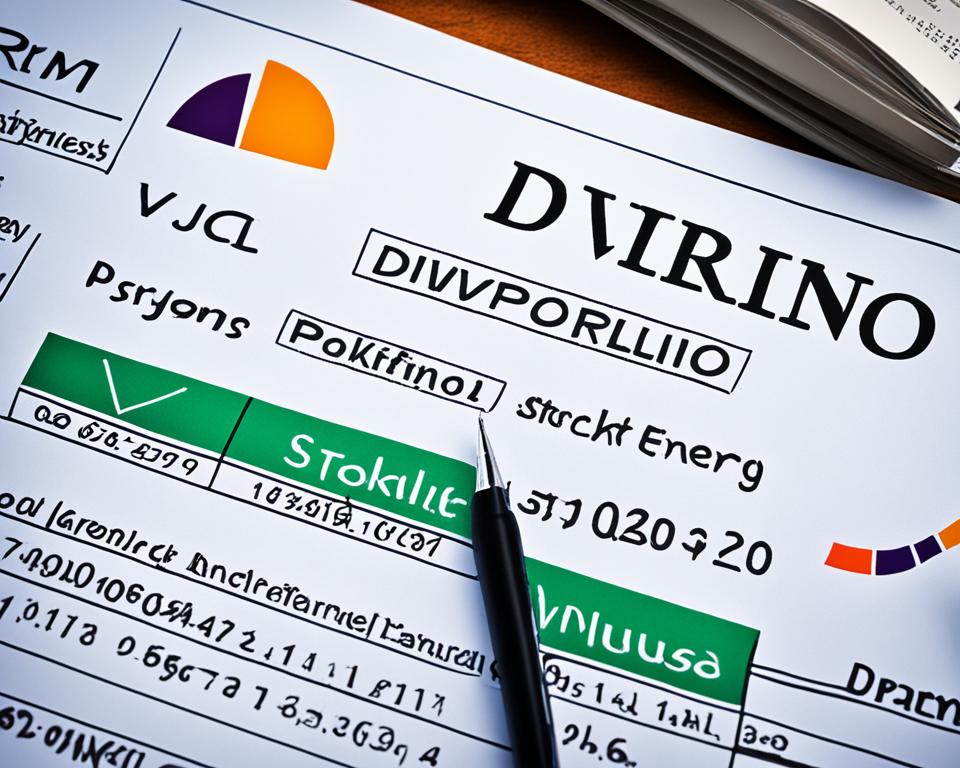Amid a plethora of investment strategies, dividend investing has emerged as a sterling path for those seeking to establish a steady stream of passive income. It stands distinct from other approaches by offering the allure of dividend income, appealing to individuals aiming to bolster their earnings without heavily engaging in day-to-day market fluctuations. Moreover, this strategy paves the way for long-term financial fortitude by accumulating a dividend portfolio characterized by dividend growth, nurturing both capital appreciation and income sustainability.
For aspirants of pragmatic wealth accumulation, dividend investing presents a balanced confluence of income and growth. The strategy isn’t just about immediate returns; it is also about carefully selecting stocks that are poised for potential dividend growth. This approach enables investors to tap into the compounding prowess of reinvesting dividends, fortifying their dividend portfolio over time. Embracing this strategy can mean employing a thoughtful blend of financial foresight and patience, catering to both the seasoned investor and the passive income enthusiast.
Key Takeaways
- Dividend investing emphasizes generating regular dividend income through a curated portfolio of dividend-paying stocks.
- This investment strategy leverages the stability and growth potential of stocks that consistently distribute a portion of their profits to shareholders.
- Creating a dividend portfolio provides a dual benefit of passive income and the potential for long-term capital gains.
- Investing with a focus on dividend growth can compound earnings and contribute to sustainable wealth accumulation.
- Dividend investing is suitable for a variety of investors, aiming to foster an equilibrium between steady income and appreciation of assets.
Introduction to Dividend Investing
The term dividend investing might conjure images of corporate giants distributing hefty cheques to their shareholders, but the concept encapsulates a far-reaching financial strategy rooted in the pursuit of passive income investing. This approach attracts those who prize a steadier, perhaps more predictable income flow over the whirlwinds of market speculation.
At its core, dividend investing involves selecting an array of dividend stocks—shares from companies renowned not just for their market presence but for a steadfast habit of sharing profits with investors. Recognizing that not all investments entail relentless pursuit of growth, this method leans towards established entities known for their dividend strategy, wherein a significant portion of their earnings routinely make their way back to shareholders’ pockets.
Such companies, often admired for their financial resilience and reliable earnings, have historically provided investors with a regular income. That additional cash can serve as an enhancement to their overall investment returns, creating a cushion or a source of revenue outside of the often volatile arenas where securities’ prices can dance unpredictably. Moreover, the allure of dividend portfolio is not merely in the immediate gratification of periodic dividends but also in the potential for capital appreciation over the longer term.
Investors are increasingly latching onto dividend investing as a means to balance their financial ecosystems. By directing funds into dividend-paying companies, they’re effectively deploying a strategy that can enrich their investment horizons with considerable passive income. This income not only provides reinforcements during fiscal storms but also contributes to a foundation of wealth accumulation that could stand the test of time.
Whether you’re well-versed in the world of stocks or a beginner finding your bearings, understanding and harnessing the power of dividends could well be a pivotal step towards realizing your financial aspirations. The journey through dividend investing begins with a discerning eye and an appreciation for the subtle intricacies that govern passive income streams.
Understanding Dividends and Their Role in Investing
As cornerstones of shareholder profits, dividends are more than mere payouts; they’re fundamental to the tapestry of savvy investing. These periodic distributions of a company’s earnings are a testament to the financial health and stability it may offer investors. Understanding the inner workings of dividends, from their issuance to the intricate policies governing their disbursement, is essential for anyone traversing the financial markets—particularly when investing in dividend stocks.
The Basics of Dividend Payments
Dividends are essentially a slice of a company’s profits carved out for those who have vested their trust, and capital, in the firm’s potential—its shareholders. Boiled down to its essence, a dividend payment is a reward, an enticement to keep investors onboard, and to attract new ones seeking to share in the company’s success. Not to be taken for granted, dividend payments fluctuate in response to the company’s profitability and its long-term strategic goals, ultimately decided by the board of directors.
Eligibility and Distribution of Dividends
Defining who reaps the benefits of dividend distribution revolves around a straightforward criterion: dividend eligibility. To partake in the profit-sharing cake, holding shares by a specified ‘record date’ is vital. Missing this cut-off by the stroke of a trading day’s bell can mean passing up on a quarter’s worth of shareholder earnings. Companies disburse these dividends on a scale ranging from monthly to annually, bringing both regularity and a measure of anticipation to the fiscal year for investors.
The stability dividends bring to a portfolio cannot be overstated; they play the role of a fiscal anchor during tumultuous market seas. Yet, it’s this same characteristic of reliability and predictability that renders them attractive, not just for the conservative investor but also for those constructing diversified portfolios with an eye on medium to long-term gains and the appeal of a passive income stream.
The distribution mechanics of dividends are straightforward—cash or sometimes stock—yet the decision process of the issuing company is anything but. Operational successes, economic forecasts, and company-specific considerations all funnel into the judgment calls made boardroom by boardroom, dividend by dividend.
By capturing a snapshot of what dividends represent, from their basic structure to the intricacies of eligibility, investors can position themselves to leverage these payments not just as mere inflows but as strategic building blocks within their broader investing framework. Indeed, the might of dividends reaches far beyond immediate liquidity, bearing implications for portfolio resilience and long-term growth strategies. Thus, the astute investor will recognize that grappling with the fabric of dividend stocks can lay the foundation for both current and future financial prosperity.
The Concept of Dividend Yield Explained
Diving into the realm of dividend investing unveils a key metric fundamental to evaluating the attractiveness of dividend-paying stocks: the dividend yield. This gauge of return is pivotal for investors focused on generating passive income through their portfolios, illuminating the efficiency of their invested capital in terms of income generation. A firm understanding of how dividend yields work and their relationship with stock price underpins astute investment decisions, helping investors to maximize their cash flow from dividends.
Calculating Dividend Yield
At its most elementary level, calculating dividend yield requires a simple formula: the annual dividends per share divided by the current stock price. This figure, expressed as a percentage, reflects the investor’s return on investment from dividends alone. For example, if a company pays out an annual dividend of $2.00 per share and its stock price hovers at $40, the dividend yield would be 5%. Such a calculation aids investors in assessing the potential income to be gained relative to the amount of money invested in a stock.
The Inverse Relationship Between Stock Price and Dividend Yield
An intriguing dynamic exists between a stock’s price and its respective dividend yield; they share an inverse relationship. As a stock price escalates, the dividend yield proportionally descends, and vice versa. This concept is integral to the philosophy of dividend investing, as it impacts the durability of the income stream provided by a portfolio of dividend-paying stocks. Investors must be vigilant in recognizing that a ballooning stock price might herald a decreasing yield and should therefore evaluate their passive income strategies in light of such fluctuations.
A thorough grasp of dividend yield not only helps maintain a steady flow of passive income but also serves as a compass guiding investors when navigating the ever-shifting terrain of the stock market.

Here is an illustrative example highlighting the key relationship between dividend yield, stock price, and dividends per share:
| Stock | Dividends per Share | Stock Price | Dividend Yield |
|---|---|---|---|
| Company A | $3.00 | $50.00 | 6% |
| Company B | $1.50 | $25.00 | 6% |
| Company A (Price Increase) | $3.00 | $60.00 | 5% |
| Company B (Price Decrease) | $1.50 | $20.00 | 7.5% |
The table encapsulates the inverse relationship where Company A’s increased stock price led to a decreased dividend yield, whereas Company B’s decreased stock price resulted in an increased dividend yield, assuming the dividend per share remains constant in both scenarios.
By contextualizing the interplay between stock price and dividend yield, savvy investors can position their portfolios to optimize cash flow and sustain their journey in dividend investing towards a more robust passive income.
Advantages of Dividend Stocks in a Portfolio
When it comes to building a robust investment portfolio, incorporating dividend stocks is akin to laying down a financial foundation capable of weathering market storms and enhancing wealth over time. These securities, renowned for their consistent payouts, serve not just as vehicles for passive income but also as instruments of stability and growth within an investment strategy. Let’s explore how dividend-bearing stocks can be the cornerstone of sound fiscal planning and a beacon for those pursuing the double-pronged goal of income and appreciation.
Portfolio Stability Through Dividends
Investors seeking portfolio stability find a resolute ally in dividend stocks. The payments received serve as a steady stream of income that can temper the ebbs and flows of market volatilities. Furthermore, this predictable income often leads to a less reactionary investment behavior, allowing investors to hold steady amid economic fluctuations. With a dividend strategy in place, your portfolio has the potential to exhibit a resiliency that is highly valued during uncertain economic climates.
Long-term Benefits of Dividend Growth
The benefits of dividend growth orbit beyond the mere accumulation of dividends. Stocks with a history of increasing their dividends tend to signal to the market a company’s confidence in its own profitability—a predictor of long-term investment prospects. The magic unfolds when dividends are reinvested, giving life to the wonder of compounding. Over the long haul, this cycle of reinvestment and growth can result in substantial capital appreciation. Hence, when dividends grow, investors don’t just accumulate income—they build a tower of escalating value piece by piece, establishing a fortress of wealth.
History has often favored such dividend strategies, with evidence pointing to dividend growth stocks frequently outstripping their non-paying counterparts. In essence, stocks that nurture their dividends present investors with a compelling fusion, coupling price appreciation with a steady cadence of passive income. For the investor wielding patience and foresight, the rewards of dividend investing can paint a very prosperous financial narrative.
Evaluating Dividend-Paying Companies
Investors seeking to enhance their portfolios with dividend-paying stocks need to evaluate the company’s financial health and its capacity to maintain dividend sustainability. These evaluations are critical because dividends offer a glimpse into the underlying fundamentals of a business and its commitment to shareholder value. A key aspect of income investing is identifying organizations with a solid dividend strategy that aligns with one’s financial goals.
When it comes to analyzing a dividend-paying company, the history of dividend payments and its yield are initial indicators of stability and growth potential. Longevity in dividend payments can often correlate with a company’s maturity and financial robustness. However, in this rapidly evolving economic climate, the past performance is not always an unequivocal guarantee of future results.
To thoroughly understand the dividends landscape, savvy investors pay close attention to a spectrum of financial metrics. These metrics shed light on not just the possibility of current dividends, but also their potential growth. Moreover, the health of the company’s finances, exemplified by its balance sheet, serves as a testament to its ability to manage debt and sustain profitability.
Dividend sustainability is paramount when selecting dividend-paying stocks. Stocks with a history of stable or growing dividends can indicate a company’s financial vitality and consistent earnings. A diligent approach involves evaluating a company’s earnings performance and future prospects, assuring that dividend payouts are not only presently secure but can potentially increase in the future.
Another vital step in income investing is reviewing the company’s competitive advantages. Not all sectors fare equally in turbulent economic seas, and companies poised with a durable competitive edge can often withstand downturns better, thereby upholding their dividend payments.
| Financial Metric | Description | Relevance to Dividend Sustainability |
|---|---|---|
| Payout Ratio | Portion of earnings paid as dividends | Assesses dividend’s impact on retained earnings and growth prospects |
| Debt-to-Equity Ratio | Company’s financial leverage | Underlines how debt could affect future dividend payments |
| Free Cash Flow | Cash available after operational expenses and investments | Indicates ability to sustain dividends from operating performance |
The table presented provides a snapshot of crucial financial metrics that should be at the forefront when evaluating a company’s dividend yield and the likelihood of its persistence. By prioritizing a company based on these indicators, investors can discern between stocks with mere high yields and those that present a balanced dividend strategy—a stratagem that integrates both income investing needs and potential capital appreciation.
Ultimately, investing in dividend-bearing stocks necessitates a thorough and thoughtful approach. It requires investors to look beyond surface-level indicators such as yield and instead delve into the depths of corporate financial statements. In doing so, investors are more likely to select companies capable of providing a reliable dividend stream while sustaining financial solidity through shifting market currents.
Characteristics of Dividend Aristocrats and Kings
Investors often look towards dividend aristocrats and dividend kings as beacons of investment quality and reliability. The hallmark of these elite stocks lies in their ability to offer consistent dividends to shareholders, standing as a testament to their enduring operational excellence and financial fortitude. Such characteristics have made them particularly attractive to those investors who value proven track records of dividend growth along with stability in their investment portfolios.
Criteria for Dividend Aristocrats
For a company to be classified as a dividend aristocrat, it must have consistently increased its dividends for at least 25 consecutive years. These companies are often found within the S&P 500, illustrating their recognition as industry leaders and stable performers. Meeting such stringent criteria highlights a firm’s dedication to their shareholders, signaling an underlying resilience and capacity for continuous profit generation despite economic turmoil.
Why Dividend Kings Are Highly Regarded
A step above aristocrats, dividend kings have the distinguished honor of having raised dividends for over 50 years in a row. This longevity signifies a corporate history replete with successful strategic decision-making and an exceptional caliber of investment quality. Investors who lean on the storied chronicle of dividend growth exuded by these companies benefit from what is often seen as a greater assurance of dividend stability and financial prudence.
The following table showcases the illustriousness of these investment titans, exemplifying the longstanding promise they hold for investors who prioritize dividend continuity and quality.
| Company | Years of Consecutive Dividend Increases | Classification |
|---|---|---|
| Procter & Gamble | Over 60 years | Dividend King |
| Johnson & Johnson | Over 55 years | Dividend King |
| 3M | Over 60 years | Dividend King |
| Walmart Inc. | Over 45 years | Dividend Aristocrat |
As evidenced by the table, these corporations are not fleeting entities but foundational figures in the world of investment, offering consistent dividends through thick and thin. Their reputations for financial stability and robust business models precede them, allowing dividend growth investing to thrive as a coveted strategy among income-focused investors. This historical consistency makes dividend aristocrats and kings a cornerstone for those looking to build a resilient, growth-oriented portfolio.

The Attractions and Pitfalls of Dividend Investing
Within the investing ecosystem, dividend investing stands out for its ability to supply investors with regular dividend income, a feature particularly desired by those seeking financial stability and passive revenue streams. This investment strategy harnesses the power of consistent payouts from equities that reward their shareholders regardless of market vicissitudes, positioning it as a beacon of predictability in the tumultuous sea of investment options.
Why Investors Favor Dividend Income
For good reason, dividend income entices a myriad of investors. It promises a steady cash flow akin to a monetary lifeline during retirement or economic downturns. This allure of financial predictability is what sets dividend investing apart. With dividends, one’s investment strategy may not just hinge upon the uncertainties of stock appreciation but enjoy the additional cushion of income generation.
Common Dividend Investing Mistakes to Avoid
However, the pursuit of dividends is not without its snares. One key mistake includes chasing after high yields that sparkle promisingly but oftentimes lack sustainability—proving to be classic examples of dividend pitfalls. When investors prioritize yield without the bedrock of robust company fundamentals, they risk financial disappointment, potentially encountering investing mistakes that can disturb the sanguine waters of a well-planned portfolio.
Furthermore, the neglect to assess the endurance of dividend sustainability or growth prospects deeply undermines the financial rigour required for enduring success in dividend investing. Below lies a table illustrating common pitfalls to guard against and practices to embrace for avoiding consequential mistakes in dividend investing.
| Pitfall | Investor Misstep | Preventive Measure |
|---|---|---|
| High Yield Temptation | Investing based solely on an attractive yield | Consider the total return perspective and company fundamentals |
| Dividend Cuts | Failing to anticipate or act upon signs of a cut | Maintain vigilance on payout ratios and earnings reports |
| Neglecting Growth Prospects | Oversight of evolving market trends affecting companies | Invest in firms with a clear roadmap for sustainable growth |
By familiarizing oneself with these insights, aspirants of dividend investing can more confidently voyage through their fiscal endeavors, capitalizing on the virtues of dividends while steering clear of common oversights that could thwart their passive income aspirations.
Strategies for Selecting Dividend Stocks
Investing in dividend stocks is an art as much as it is a science. To enhance their portfolio, astute investors employ investment strategies that emphasize not only dividend yield but also the sustainable dividend growth and financial health of the companies they select. This balanced approach mitigates risk and aims for long-term income and capital appreciation.
Focusing on Dividend Growth
True investment strategies look beyond the immediate allure of high yields to the more telling sign of long-term profitability—dividend growth. Thriving companies tend to increase their dividends over time, reflecting confidence in their financial prospects and a commitment to rewarding shareholders. Thus, focusing on dividend growth is not just selecting dividend stocks; it’s selecting stock with a future.
Assessing Financial Health and Dividend Sustainability
Furthermore, while selecting dividend stocks, investors should delve into the financial health of a company. Assessing factors such as earnings consistency, debt levels, and management efficacy provides insight into dividend sustainability. An astute investor examines balance sheets, profit margins, and payout ratios to ensure the dividends are not only generous but also grounded in solid financial performance.
Here’s an indicative table that layers financial metrics with descriptions and their significance to dividend sustainability, helping investors in their decision-making process:
| Financial Metric | Description | Significance to Dividend Stocks |
|---|---|---|
| Earnings Growth | Consistent increase in earnings per share | Indicates potential for sustainable and growing dividends |
| Debt-to-Equity Ratio | Measure of a company’s financial leverage | Lower ratios imply less financial risk impacting dividend payments |
| Return on Equity | Profitability metric from a shareholder’s perspective | Higher ROE may suggest efficient management and robust financial health |
| Payout Ratio | Percentage of earnings paid out as dividends | A moderate ratio suggests room for dividend growth and financial flexibility |
In conclusion, by selecting dividend stocks with an eye for both dividend growth and financial health, investors are more likely to secure a sustainable source of income. The careful vetting of a company’s financial stability and growth prospects is what separates a promising investment opportunity from a potential dividend trap, setting the stage for long-term capital gains.
Tax Implications of Dividend Income
For individuals investing in dividend-paying assets, navigating the labyrinth of investment taxation is crucial. Dividends, which constitute a substantial portion of returns, come attached with their own set of tax implications, often causing bewilderment among investors. Acquiring an understanding of how dividends are taxed is a necessary step towards ensuring the efficacious management of one’s dividend income.
Primarily, there are two types of dividends that investors will encounter: qualified dividends and non-qualified dividends. Their distinction lies in the rate at which they are taxed and is contingent upon specific IRS criteria. Qualified dividends benefit from being taxed at the capital gains rates, which are typically lower than the rates for ordinary income.
However, high-yield investments such as Real Estate Investment Trusts (REITs) and Master Limited Partnerships (MLPs) may yield dividends that are often taxed as ordinary income. This distinction makes it imperative for investors to consult financial professionals or utilize tax software to comprehend the exact tax implications of their investments and strategize accordingly.
In order to classify as qualified, dividends must be paid by a U.S. corporation or a qualifying foreign company and must be held for a specific minimum period. Additional requirements also apply, ensuring that not all dividends received will automatically fall into the favorable qualified category.
Recognizing one’s tax bracket is thus essential, as the rate at which qualified dividends are taxed depends on it. For instance, those in the highest tax bracket might see their dividends taxed at 20%, while investors in the lower tax brackets could enjoy a 0% rate on their qualified dividends. This can translate into significant savings and influence one’s investment strategy.
Below is a table that illustrates the differences in tax rates between qualified dividends and ordinary dividends for various tax brackets:
| Tax Bracket | Qualified Dividends Tax Rate | Ordinary Dividends Tax Rate |
|---|---|---|
| 10% to 15% | 0% | 10% to 15% |
| 15% to 24% | 15% | 15% to 24% |
| 24% to 37% | 15% to 20% | 24% to 37% |
| 37% and above | 20% | 37% |
Investors maintaining diverse portfolios that encompass a mix of regular and qualified dividend-paying securities must maintain heightened diligence at tax time. The tax impact on the overall dividend income could prove to be a defining factor in the total returns achieved from one’s investment portfolio.
Ultimately, an investor would be well-advised to stay updated on tax legislation changes, which could alter the current framework and potentially affect the attractiveness of dividend investing. As such, the intricacies of investment taxation call for an informed approach, blending tax efficiency with investment decision-making to optimize the benefits of dividend income.
Dividend Reinvestment Plans (DRIPs) Explored
For investors with an eye on the long game, Dividend Reinvestment Plans, often referred to as DRIPs, serve as a strategic mechanism to elevate their investment portfolios. Synonymous with the philosophy of passive investing, DRIPs offer a quintessential feature: they facilitate the automatic reinvestment of dividend payouts back into additional shares of the issuing company. This seamless process fosters the principle of compound returns, a potent force in the world of investing.
The allure of DRIPs lies in their ability to simplify the journey toward accumulating wealth. Investors partaking in a dividend reinvestment plan may witness their holdings incrementally climb without the necessity of active management. As dividends are paid, the equivalent value is used to purchase more shares, often at no additional transaction cost, which in turn may pay further dividends, setting a cycle of compounding growth into motion.
Moreover, DRIPs inherently implement the strategy of dollar-cost averaging. By consistently purchasing shares over time, regardless of price fluctuations, investors potentially reduce the impact of market volatility. Dollar-cost averaging through DRIPs ensures one is not solely buying at market peaks, and over time, this can average out the acquisition cost of shares.
- Dividend reinvestment harnesses earnings to increment shareholdings.
- DRIPs engender compound returns by reinvesting dividends.
- Passive investing strategy facilitating dollar-cost averaging.
While DRIPs represent an advantageous avenue for investors to expand their portfolios and beef up the impact of dividends on wealth creation, they also serve as a testament to the enduring value of passive strategies in sound financial planning. The embodiment of a ‘set it and forget it’ approach, DRIPs allow investors to entrust their reinvestment strategy to the compound power of dividend returns and the steady rhythm of market growth.
Comparing Dividend Investing to Other Investment Approaches
Within the diverse universe of investment strategies, dividend investing marks its territory by providing investors with a potential blend of steady income and appreciation. Contrastingly, issues like growth investing and value investing hinge on the prospects of capital gains and market price corrections, respectively. Each strategy holds distinctive allure depending on an investor’s goals, risk tolerance, and timeline. Scrutinizing their differences affords an investor a guide to tailoring a personal strategy that resonates with an individual investment philosophy and aids in portfolio diversification.
Dividend Investing vs. Growth Investing
Whereas dividend investing stands out for its pursuit of regular income via dividend payouts, growth investing targets companies expected to surge at an above-average rate. Growth investors often forgo current yields for the promise of substantial future earnings and capital appreciation. This approach can lead to impressive gains, but it bears the volatility and risks associated with rapidly scaling businesses.
Dividend Investing vs. Value Investing
On the other end of the spectrum, value investing is akin to treasure hunting, seeking stocks perceived to trade below their intrinsic values. While both value and dividend investing share the common thread of looking for undervalued opportunities, dividend investing couples this with the pursuit of consistent dividend payouts. A well-executed dividend investment strategy might not only secure undervalued stocks but will also position the investor to benefit from potential stock price recovery and regular dividend income, thus contributing to both portfolio stability and growth.
Let’s consider the attributes of these investment strategies in a comparative table:
| Investment Strategy | Main Focus | Typical Risk Profile | Investor Benefit |
|---|---|---|---|
| Dividend Investing | Regular income from dividends | Low to Moderate | Income & moderate growth potential, portfolio diversification |
| Growth Investing | Capital appreciation | High | High growth potential in stock value |
| Value Investing | Undervalued stocks with appreciation potential | Low to Moderate | Price gains upon market correction |
Each of these investment strategies boasts unique advantages and operates best within certain market conditions and investment timeframes. Dividend investing is lauded for its role in establishing a stable, income-generating portfolio, often with lower volatility. Contrastingly, growth investing and value investing may offer higher returns but come hand-in-hand with higher market sensitivity and risk.
For investors seeking a harmonious blend of income and capital appreciation, dividend investing often shapes a middle ground, providing a gateway to portfolio diversification and a buffer against market volatility. It promotes an investment style that not only targets returns through stock price gains but also capitalizes on income streams through dividends.
How to Create a Solid Dividend Investing Plan
Embarking on the journey of creating a dividend plan involves a strategic approach to aligning one’s financial resources with future aspirations, mitigating investment risk, and cultivating a reliable income stream. To architect a plan that stands the test of time and market turbulence, investors must exercise due diligence in defining their portfolio allocation, choosing investment vehicles, and sculpting a dividend strategy that resonates with their unique profile and targets.
Assessing Risk and Determining Portfolio Allocation
The cornerstone of crafting a dividend investing blueprint is evaluating one’s tolerance for risk. This self-assessment influences decisions on portfolio allocation, shaping how much capital is invested in high-yield securities versus growth-oriented dividend payers. Investment objectives, time horizon and individual risk appetite dictate the balance between seeking higher dividend yields and maintaining capital preservation. An investor’s financial comfort can pivot based on market conditions, personal circumstances, and changing financial goals.

To culminate in an effective dividend investing plan, the investor must juggle risk with potential returns, ensuring that their dividend portfolio fortifies their financial strategy without exposing them to undue volatility.
Investment Vehicles for Dividend Investing
Diverse investment vehicles cater to investors seeking to enhance their dividend streams. Options range from blue-chip stocks with storied histories of robust dividend payments to specialized ETFs and mutual funds offering diversified exposure to varying dividend strategies. The vehicle an investor chooses should correspond to their assessed risk profile and desired portfolio allocation.
In the seascape of potential investments, here’s a visual guide elucidating various investment vehicles and their attributes:
| Investment Vehicle | Characteristics | Investor Consideration |
|---|---|---|
| Individual Dividend Stocks | Direct ownership in companies with dividend payout histories. | Allows for precise selection but requires thorough research and active monitoring. |
| Dividend ETFs | Basket of stocks providing dividend yield diversification. | Reduces risk through exposure to multiple dividend-paying companies. |
| Dividend Mutual Funds | Managed funds focusing on dividend income strategies. | Offers professional management with potentially higher fees than ETFs. |
| Dividend Income Funds | Funds specifically targeting high current dividend income. | Ideal for investors seeking regular income payouts. |
Selecting the right vehicle involves considering fees, performance history, dividend yield, and the fund’s adherence to desired dividend strategies. By navigating the landscape of available investment vehicles with keen insight, investors can sail toward their goal of a solid, income-generating portfolio.
Real Case Examples of Successful Dividend Investing
Exploring real case examples of successful dividend investing unveils a powerful narrative on how savvy investors derive dividend income and secure impressive investment returns. These companies are often the pillars of investment portfolios, demonstrating how a commitment to shareholder value through regular, increasing dividends can be a fountain of financial prosperity.
Procter & Gamble (P&G), a household name with a diversified portfolio of consumer goods, has established itself as a dividend stalwart. A member of the elite group known as Dividend Kings, P&G has increased its dividend for more than 60 consecutive years. This level of consistent performance underlines a deep-rooted financial stability and an investor-centric policy that has rewarded shareholders with both dividend income and capital gains.
Chevron Corporation, the energy giant, stands as another testament to successful dividend investing. With a history of regular payouts and a strong balance sheet, Chevron exemplifies the ideal blend of income-generation and growth potential. Despite the cyclical nature of the energy sector, Chevron has managed to maintain and grow its dividends, highlighting the company’s strategic operations and prudent investment practices.
Similarly, Lowe’s Companies, Inc., a leading home improvement retailer, has consistently delivered value to its shareholders through dividends. Lowe’s is not only a Dividend Aristocrat but also on the verge of becoming a Dividend King, with dividend increases exceeding five decades. The company’s growth trajectory and dividend track record exhibit how successful dividend investing can align with enduring enterprise success and shareholder wealth creation.
These companies collectively offer a blueprint for effective dividend investing—steadily increasing payouts backboned by solid business models and financial acumen. They serve as case examples that aptly reflect the principle: loyal investors who have held onto these shares have seen their trust translated into meaningful dividend income, complemented by appreciation in share prices over the long term.
| Company | Sector | Years of Consecutive Dividend Increases | Notes |
|---|---|---|---|
| Procter & Gamble | Consumer Goods | 60+ | Dividend King with diverse brand portfolio |
| Chevron Corporation | Energy | 30+ | Resilient dividend policy despite industry volatility |
| Lowe’s Companies, Inc. | Retail | 50+ | Nearing Dividend King status with consistent growth |
Successful dividend investing doesn’t occur in a vacuum; these case examples are built upon the foundation of shrewd management and a commitment to shareholder returns. Their strength lies not just in the dividends they offer, but in the overall integrity and foresight of their business operations. As Procter & Gamble, Chevron, and Lowe’s have demonstrated, solid dividend-paying stocks can underpin a strategy culminating in substantial long-term investment returns and a robust income stream.
Conclusion
As we conclude our comprehensive exploration of dividend investing, it’s imperative to reiterate the role this strategy plays in fostering a stable financial future. The journey we’ve embarked upon underscores the value of dividend investing as not merely a tactic for generating passive income, but as a holistic approach towards building wealth. It’s a gateway leading to both immediate financial returns and the prospect of long-term capital growth.
Recap of Dividend Investing Essentials
Dividend investing caters to a wide array of individuals, from those drawing closer to retirement, favoring steady income streams, to those in their wealth-building phase, looking for an investment with growth potential. The investment essentials highlighted over the course of this article convene around prudent stock selection married with an immersive understanding of a company’s ability to grow and sustain dividends. It also involves being cognizant of tax implications, and the significance of employing strategies such as Dividend Reinvestment Plans (DRIPs) to capitalize on the wonders of compounding.
Final Thoughts on Building Wealth Through Dividends
Incorporating dividends into your investment portfolio can be a powerful mechanism for building wealth and ensuring financial stability. Embracing the discipline of dividend investing requires patience and a commitment to deep financial diligence. But for those willing to adhere to the tenets of this steadfast strategy, the potential rewards extend far beyond the allure of immediate income. It promises a kinship with a heritage of enduring profits, a chance to align with the top echelons of prudent investing pioneers, securing one’s financial future with each deliberate and informed decision. Dividend investing, indeed, stands tall as a bulwark against the vagaries of time and economic uncertainty.
FAQ
What is dividend investing and how does it differ from other investment strategies?
Dividend investing is a strategy focused on buying stocks of companies that pay dividends, which are a share of profits distributed to shareholders. This approach is distinct from other investment strategies as it seeks to generate income through regular dividend payments. In contrast, growth investing emphasizes capital gains through increasing stock prices, while value investing aims for stocks that are undervalued by the market.
What are the basics of dividend payments and their role in investing?
Dividends are portions of a company’s earnings that are paid out to shareholders. They provide a source of passive income and can contribute to portfolio stability. Companies with a consistent dividend payment history inspire confidence in their financial health and often attract long-term investors focused on income generation.
How is dividend yield calculated, and what does it signify?
Dividend yield is calculated by dividing the annual dividends per share by the stock’s current price. It represents the percentage of return an investor would earn from dividends at the current stock price. A higher yield can indicate a better cash flow from dividends but also warrants scrutiny as it could signal potential problems with the stock.
What advantages do dividend stocks have in a portfolio?
Dividend stocks can provide stability by supplying a passive income stream, even in volatile markets. They can also lead to long-term portfolio growth through the power of compound interest, especially when dividends are reinvested. Consistently growing dividends might also correlate with a company’s increasing stock price, beneficial for capital appreciation.
How do investors evaluate the financial health and dividend sustainability of a company?
Investors typically scrutinize the company’s financial statements, looking for stable earnings, a manageable level of debt, and a history of dividend payments. The payout ratio – the portion of earnings paid out as dividends – is also key in evaluating sustainability, with a lower payout ratio often preferred.
What are Dividend Aristocrats and Dividend Kings, and why are they regarded as reliable investments?
Dividend Aristocrats are companies in the S&P 500 index that have increased their dividends for at least 25 consecutive years, while Dividend Kings have done so for over 50 years. These companies are considered reliable investments due to their long track record of providing shareholders with growing dividends.
Why do investors favor dividend income, and what pitfalls should they avoid in dividend investing?
Investors often favor dividend income for its ability to provide stable, recurring cash flow, particularly beneficial for retirees or those seeking consistent income. However, they should be wary of unsustainable high yields and companies that may cut dividends in economic downturns. Ignoring company fundamentals and chasing yield alone are common pitfalls.
What strategies should investors use when selecting dividend stocks?
Investors should focus on dividend growth and the company’s overall financial health. They should seek out stocks with potential for appreciation as well as income, and avoid those with excessively high dividend yields that may not be sustainable. Assessing a company’s competitive position and management effectiveness is also crucial.
What are the tax implications of dividend income?
Dividend income can be taxed at different rates depending on whether dividends are qualified or non-qualified. Qualified dividends are taxed at the more favorable capital gains rates, while non-qualified dividends are taxed at ordinary income rates. Understanding the classification and tax rate of dividends is paramount for optimizing tax efficiency in an investment strategy.
How do Dividend Reinvestment Plans (DRIPs) work, and what are their benefits?
DRIPs allow investors to automatically reinvest their dividends into additional shares of the issuing company. The benefits of DRIPs include taking advantage of compounding returns, purchasing shares without paying commissions, and leveraging dollar-cost averaging to potentially lower the average cost basis of holdings.
How does dividend investing compare to growth and value investing?
Dividend investing focuses on income through dividends and usually involves investment in established companies with consistent earnings. Growth investing seeks companies with above-average growth prospects, typically foregoing current income for future capital appreciation. Value investing involves buying undervalued stocks that investors believe will eventually reflect their intrinsic worth. Dividend investing offers income plus potential appreciation, growth investing offers higher risk-reward potential through capital gains, and value investing seeks mispriced opportunities that offer upside correction potential.
What factors should be considered when creating a solid dividend investing plan?
When building a dividend investing plan, individuals should consider their risk tolerance, the impact of dividend income on their overall portfolio, and the types of investment vehicles that align with their goals, whether individual stocks, ETFs, or mutual funds. A well-researched and diversified approach considering market conditions and personal financial objectives is key to a successful strategy.
Can you provide real-world examples of successful dividend investing?
Companies like Procter & Gamble, Chevron, and Lowe’s are prominent examples of successful dividend investing. They have a history of consistently paying and increasing dividends, showcasing the potential for both income growth and capital appreciation. Their performance demonstrates the benefits a strong dividend strategy can have in creating wealth and financial stability for shareholders.
What are the essentials of dividend investing, and how can it help in building wealth?
The essentials of dividend investing include a focus on companies with a stable dividend payment history, reasonable payout ratios, and the potential for dividend growth. Investors should seek a balance between income and capital appreciation while being mindful of tax implications and the strategies for reinvestment. By doing so, dividend investing can provide reliable passive income and contribute to building long-term wealth and financial stability.












